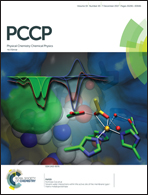Tuning the surface structure and conductivity of niobium-doped rutile TiO2 single crystals via thermal reduction
Abstract
We report on the systematic exploration of electronic and structural changes of Nb-doped rutile TiO2(110) single crystal surfaces due to the thermoreduction under ultra-high vacuum conditions (without sputtering), with comparison to undoped TiO2(110) crystals. It has been found that the surface of the doped sample undergoes a previously unknown transition during reduction above 850 °C, as provided by LEED, STM and LC-AFM. This transition involves a change from heterogeneous conductivity (due to the presence of conducting filaments) to homogeneous conductivity, connected with a new (4 × 2) reconstruction of rows parallel to the [001] direction. DFT calculations suggest substitution of Ti by Nb atoms in the first atomic layer. Due to the strong reducing conditions during annealing, oxygen is released from the crystal and Nb diffuses from the subsurface into the bulk, agglomerating however on the surface, as shown by SIMS depth profiling. We present that 0.5% Nb doping significantly influences the reduction process and in turn the structural properties of the surface by supporting the evolution of the new reconstruction. It is shown that the thermal treatment of TiO2:Nb under low oxygen partial pressure gives an opportunity to tune the electrical conductivity and work function of the surface.



 Please wait while we load your content...
Please wait while we load your content...